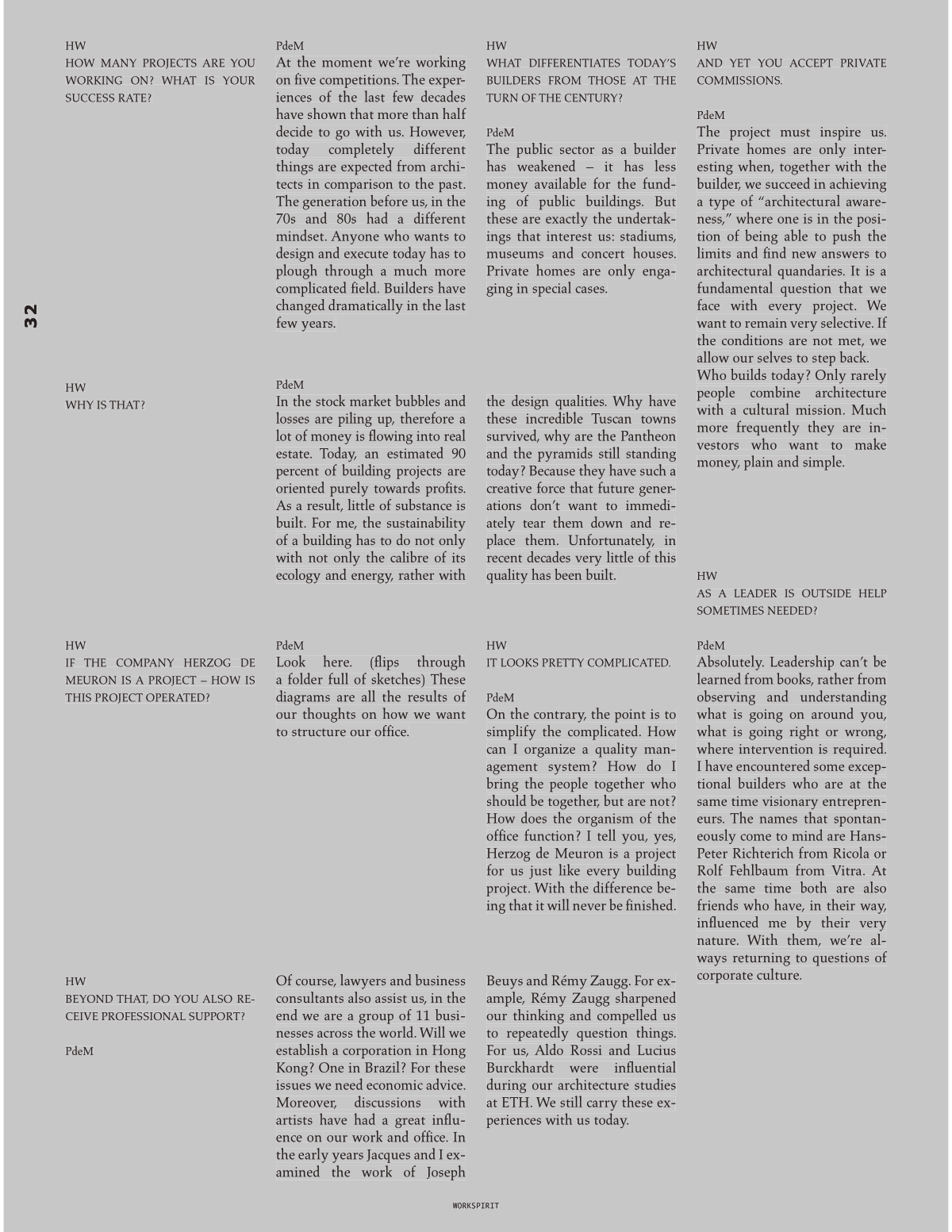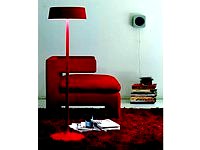��
��
WORKSPIRIT
HW
AS A LEADER IS OUTSIDE HELP
SOMETIMES NEEDED?
PdeM
Absolutely. Leadership can’t be
learned from books, rather from
observing and understanding
what is going on around you,
what is going right or wrong,
where intervention is required.
I have encountered some excep-
tional builders who are at the
same time visionary entrepren-
eurs. The names that spontan-
eously come to mind are Hans-
Peter Richterich from Ricola or
Rolf Fehlbaum from Vitra. At
the same time both are also
friends who have, in their way,
infl uenced me by their very
nature. With them, we’re al-
ways returning to questions of
corporate culture.
HW
WHAT DIFFERENTIATES TODAY’S
BUILDERS FROM THOSE AT THE
TURN OF THE CENTURY?
PdeM
The public sector as a builder
has weakened – it has less
money available for the fund-
ing of public buildings. But
these are exactly the undertak-
ings that interest us: stadiums,
museums and concert houses.
Private homes are only enga-
ging in special cases.
HW
WHY IS THAT?
HW
AND YET YOU ACCEPT PRIVATE
COMMISSIONS.
PdeM
The project must inspire us.
Private homes are only inter-
esting when, together with the
builder, we succeed in achieving
a type of “architectural aware-
ness,” where one is in the posi-
tion of being able to push the
limits and fi nd new answers to
architectural quandaries. It is a
fundamental question that we
face with every project. We
want to remain very selective. If
the conditions are not met, we
allow our selves to step back.
Who builds today? Only rarely
people combine architecture
with a cultural mission. Much
more frequently they are in-
vestors who want to make
money, plain and simple.
PdeM
In the stock market bubbles and
losses are piling up, therefore a
lot of money is fl owing into real
estate. Today, an estimated 90
percent of building projects are
oriented purely towards profi ts.
As a result, little of substance is
built. For me, the sustainability
of a building has to do not only
with not only the calibre of its
ecology and energy, rather with
the design qualities. Why have
these incredible Tuscan towns
survived, why are the Pantheon
and the pyramids still standing
today? Because they have such a
creative force that future gener-
ations don’t want to immedi-
ately tear them down and re-
place them. Unfortunately, in
recent decades very little of this
quality has been built.
HW
IF THE COMPANY HERZOG DE
MEURON IS A PROJECT – HOW IS
THIS PROJECT OPERATED?
HW
BEYOND THAT, DO YOU ALSO RE-
CEIVE PROFESSIONAL SUPPORT?
PdeM
HW
HOW MANY PROJECTS ARE YOU
WORKING ON? WHAT IS YOUR
SUCCESS RATE?
PdeM
At the moment we’re working
on fi ve competitions. The exper-
iences of the last few decades
have shown that more than half
decide to go with us. However,
today
completely
different
things are expected from archi-
tects in comparison to the past.
The generation before us, in the
70s and 80s had a different
mindset. Anyone who wants to
design and execute today has to
plough through a much more
complicated fi eld. Builders have
changed dramatically in the last
few years.
PdeM
Look
here.
(fl ips
through
a folder full of sketches) These
diagrams are all the results of
our thoughts on how we want
to structure our offi ce.
HW
IT LOOKS PRETTY COMPLICATED.
PdeM
On the contrary, the point is to
simplify the complicated. How
can I organize a quality man-
agement system? How do I
bring the people together who
should be together, but are not?
How does the organism of the
offi ce function? I tell you, yes,
Herzog de Meuron is a project
for us just like every building
project. With the difference be-
ing that it will never be fi nished.
Of course, lawyers and business
consultants also assist us, in the
end we are a group of 11 busi-
nesses across the world. Will we
establish a corporation in Hong
Kong? One in Brazil? For these
issues we need economic advice.
Moreover,
discussions
with
artists have had a great infl u-
ence on our work and offi ce. In
the early years Jacques and I ex-
amined the work of Joseph
Beuys and Rémy Zaugg. For ex-
ample, Rémy Zaugg sharpened
our thinking and compelled us
to repeatedly question things.
For us, Aldo Rossi and Lucius
Burckhardt
were
infl uential
during our architecture studies
at ETH. We still carry these ex-
periences with us today.
��
��
WORKSPIRIT
HW
AS A LEADER IS OUTSIDE HELP
SOMETIMES NEEDED?
PdeM
Absolutely. Leadership can’t be
learned from books, rather from
observing and understanding
what is going on around you,
what is going right or wrong,
where intervention is required.
I have encountered some excep-
tional builders who are at the
same time visionary entrepren-
eurs. The names that spontan-
eously come to mind are Hans-
Peter Richterich from Ricola or
Rolf Fehlbaum from Vitra. At
the same time both are also
friends who have, in their way,
infl uenced me by their very
nature. With them, we’re al-
ways returning to questions of
corporate culture.
HW
WHAT DIFFERENTIATES TODAY’S
BUILDERS FROM THOSE AT THE
TURN OF THE CENTURY?
PdeM
The public sector as a builder
has weakened – it has less
money available for the fund-
ing of public buildings. But
these are exactly the undertak-
ings that interest us: stadiums,
museums and concert houses.
Private homes are only enga-
ging in special cases.
HW
WHY IS THAT?
HW
AND YET YOU ACCEPT PRIVATE
COMMISSIONS.
PdeM
The project must inspire us.
Private homes are only inter-
esting when, together with the
builder, we succeed in achieving
a type of “architectural aware-
ness,” where one is in the posi-
tion of being able to push the
limits and fi nd new answers to
architectural quandaries. It is a
fundamental question that we
face with every project. We
want to remain very selective. If
the conditions are not met, we
allow our selves to step back.
Who builds today? Only rarely
people combine architecture
with a cultural mission. Much
more frequently they are in-
vestors who want to make
money, plain and simple.
PdeM
In the stock market bubbles and
losses are piling up, therefore a
lot of money is fl owing into real
estate. Today, an estimated 90
percent of building projects are
oriented purely towards profi ts.
As a result, little of substance is
built. For me, the sustainability
of a building has to do not only
with not only the calibre of its
ecology and energy, rather with
the design qualities. Why have
these incredible Tuscan towns
survived, why are the Pantheon
and the pyramids still standing
today? Because they have such a
creative force that future gener-
ations don’t want to immedi-
ately tear them down and re-
place them. Unfortunately, in
recent decades very little of this
quality has been built.
HW
IF THE COMPANY HERZOG DE
MEURON IS A PROJECT – HOW IS
THIS PROJECT OPERATED?
HW
BEYOND THAT, DO YOU ALSO RE-
CEIVE PROFESSIONAL SUPPORT?
PdeM
HW
HOW MANY PROJECTS ARE YOU
WORKING ON? WHAT IS YOUR
SUCCESS RATE?
PdeM
At the moment we’re working
on fi ve competitions. The exper-
iences of the last few decades
have shown that more than half
decide to go with us. However,
today
completely
different
things are expected from archi-
tects in comparison to the past.
The generation before us, in the
70s and 80s had a different
mindset. Anyone who wants to
design and execute today has to
plough through a much more
complicated fi eld. Builders have
changed dramatically in the last
few years.
PdeM
Look
here.
(fl ips
through
a folder full of sketches) These
diagrams are all the results of
our thoughts on how we want
to structure our offi ce.
HW
IT LOOKS PRETTY COMPLICATED.
PdeM
On the contrary, the point is to
simplify the complicated. How
can I organize a quality man-
agement system? How do I
bring the people together who
should be together, but are not?
How does the organism of the
offi ce function? I tell you, yes,
Herzog de Meuron is a project
for us just like every building
project. With the difference be-
ing that it will never be fi nished.
Of course, lawyers and business
consultants also assist us, in the
end we are a group of 11 busi-
nesses across the world. Will we
establish a corporation in Hong
Kong? One in Brazil? For these
issues we need economic advice.
Moreover,
discussions
with
artists have had a great infl u-
ence on our work and offi ce. In
the early years Jacques and I ex-
amined the work of Joseph
Beuys and Rémy Zaugg. For ex-
ample, Rémy Zaugg sharpened
our thinking and compelled us
to repeatedly question things.
For us, Aldo Rossi and Lucius
Burckhardt
were
infl uential
during our architecture studies
at ETH. We still carry these ex-
periences with us today.







